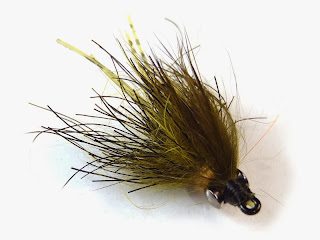The Primordial Carp Stew has been one of my most productive carp flies since I originally wrote about it almost three years ago. The laterally flattened profile seems to appeal to carp and the rub-a-dub body has great action.
How good is the action? Take a look:
In 2011 I was using three basic color combinations: A rust, olive and grey. In the years since I have found the olive and rust to be the most productive. In particular the olive seems to be very flexible and it seems to be mistaken for many food sources including crayfish, leaches and even larger nymphs.
I have also worked out a couple of other color combinations that have seen limited service. In particular black and yellow have caught a carp or two.
Standard Recipe:
- Hook: Gamakatsu SL-45 size 6 and 8
- Thread: 140 denier Ultra Thread
- Eyes: 1/8" Dazzle Eyes, Black
- Weight: 8 wraps of .025" lead
- Body: Swishers Rub-A-Dub applied in a dubbing loop.
- Accent Collar: A contrasing color dubbing between the Rub-A-Dub and eyes
- Tail: 4 nymph sized sili legs splayed
- Belly: 4 flexi-floss strands Beard: Rabbit hair from a rabbit strip
Color Combos: The Olive and Rust are my go-to color combos but I have had success with several.
- RUST - Rust is a standard carp color in general and seems to work better in the summer.
- Fl orange thread Orange Rub-A-Dub body
- Bright orange collar
- Rust beard
- Light brown nymph sili-legs
- Orange / Black MFC Speckled Sexi-legs (a flexi-floss)
- OLIVE - Seems to work better in spring and fall.
- Black thread
- Olive Rub-A-Dub body
- Whitlock's squirrel SLF collar
- Dark olive beard
- Light olive nymph sili-legs
- Olive / Black MFC Speckled Sexi-legs (a flexi-floss)
- YELLOW - Has excellent visibility for both the carp and the angler in slightly stained water.
- Olive thread
- Yellow Rub-A-Dub body
- Whitlock's squirrel SLF collar
- Golden olive beard
- Light olive nymph sili-legs
- Yellow / Black MFC Speckled Sexi-legs (a flexi-floss)
- BLACK - I frequently use black flies in extremely off-color water
- Black thread
- Black Rub-A-Dub body Olive dubbed collar with some flash
- Black beard
- Dark olive nymph sili-legs
- Olive / Black MFC Speckled Sexi-legs (a flexi-floss)
Variations:
- WEIGHT: The standard design is heavily weighted for medium depths and / or current. In shallow and still-water situations I will fish a variant with 3 to 5 wraps of lead and small stainless steel bead-chain.
- BELLY: In the past I have used the same sili-legs used to make the tail to make the belly. Unfortunately the belly takes a beating hitting the water and this has proven to not be a durable option. I have also tried various rubber sheeting materials with similar results. I now use flexi-floss due to its ridiculous strength.









Sweet flies. I'm gonna have to tie some and give them a try.
ReplyDeleteAwesome tie. What type of SLF dubbing do you use? I can only find Whitlock's red squirrel nymph (abdomen and thorax) not a normal squirrel color.
ReplyDeleteThanks, and congrats on the crust.
Thanks Zakoday. I see you just started a Blog. Good luck! The Red Squirrel Abdomen is what I use. Very pretty blend. I am pretty sure this is also what Jay Zimmerman uses on his Rust Backstabber which is why I knew of it.
ReplyDeleteHello, I have been trying some of these awesome patterns. Do you have any tips for getting the rub a dub loop to fill better? I am having some trouble getting a good dubbing loop with it.
ReplyDeleteThanks
Zack, I had trouble at first too. The first 5 or 6 flies I tried were pretty sad. The dubbing loop part of this video by Mr. Jay Zimmerman helped me allot: http://www.youtube.com/watch?v=0CbHm8EtoQs. I pretty much fill the dubbing loop exactly like he does for the orange part of his tail like for the crust and about 2/3 that lenght for the stew. Just dont spin it at tight as he does. Then after you spin it really rough it up and use your scissors to break or pull out some of the rubber legs and rabbit that gets fouled up in the spinning step. Good luck!
ReplyDeleteHmmm...I have used the masters name in vain twice in two comments. You might say I am a fan of Jay Zimmermans videos! Watch them all, they are some of the best tying videos I have seen.
ReplyDeletethanks a ton
ReplyDeleteI am so impressed with your great work and you have very good research about carp wishing how do you position our rods? Do you have the tips in the water? Do you set them both up to point straight ahead? Or do you separate them onto individual bank sticks based on the fact you have one swim to the left of them in the margins and one swim straight ahead at the island?
ReplyDelete